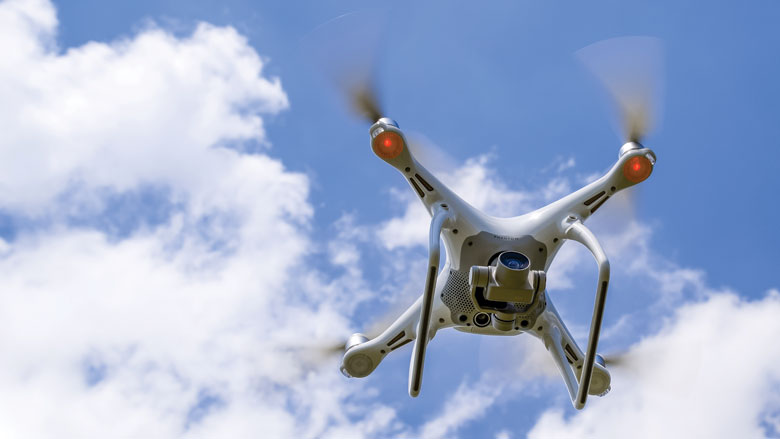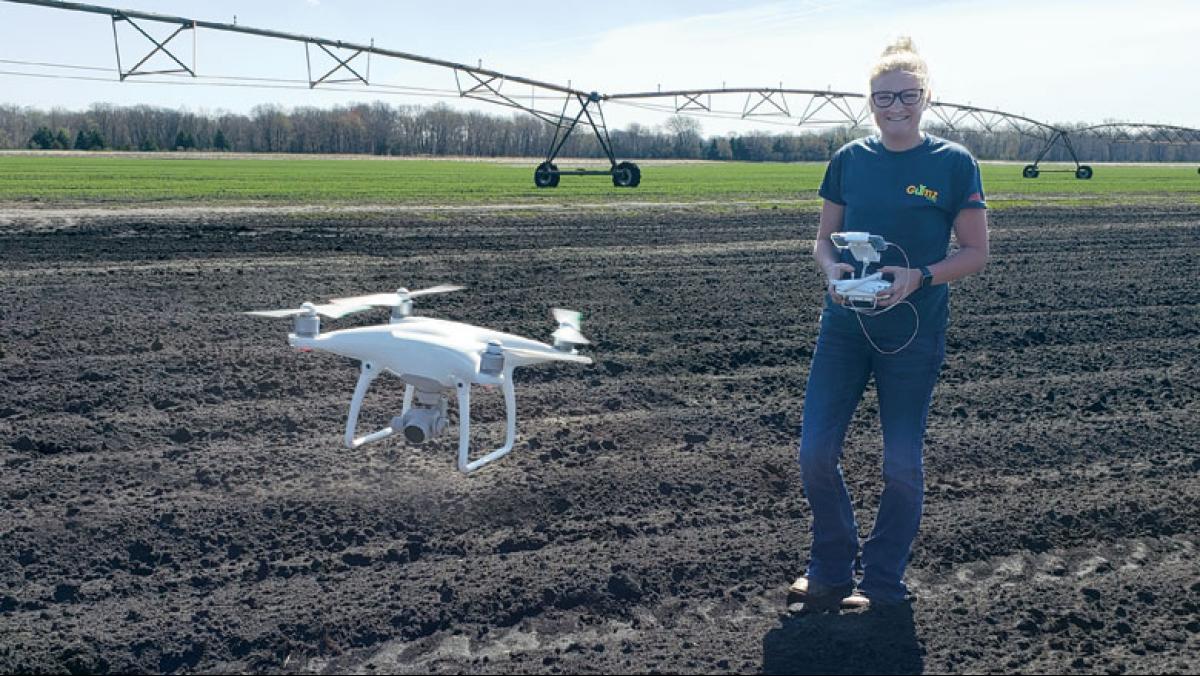From a hundred feet in the air, Moriah Rataczak inspects the fields of Gumz Farms in Central Wisconsin. Soaring through the sky like a hawk, she weaves back and forth, looking down over thousands of acres of mint, onions, potatoes, corn, and soybeans. It’s early spring, and Rataczak is checking for new growth in fields throughout Adams, Columbia, Marquette, and Sauk Counties. “I’m looking for crop emergence, seeing how the potatoes and onions are coming up,” says the 22-year-old precision agronomist.
Later in the growing season, Rataczak’s mission changes. “That’s when I’m checking for overall crop health across the field,” she explains, adding that even from a hundred feet up, “I can tell the difference in how a crop is doing based on the different shades of green, so I’m looking at how the crop’s growing or if it’s deficient and needs more nutrients.”
For her work, Rataczak prefers a view from above to one from the ground. “I can and I still do walk the field,” she says. “But I can’t see everything that I can from above. So if there’s something wrong, I might miss that spot.”
To capture the all-encompassing, elevated perspective that she’s come to rely on, Rataczak isn’t inside a plane or helicopter—she’s using a drone.
Her drone isn’t like the fixed-wing, airplane-shaped devices used by the military during the war on terrorism and later popularized by battlefield-based TV shows. Instead, Rataczak uses a DJI brand Phantom 4, a consumer-grade drone purchased for about $1,000. The drone, known as a quadcopter because of its four whirling blades, doesn’t fly so much as it hovers. It’s outfitted with a pivoting camera to capture high resolution video and images. “The drone can see far more than a human,” she says. “It’s like another pair of eyes for me—it’s my aerial eyes.”
As she pilots the remote-controlled aircraft from the ground, Rataczak instantly sees what the quadcopter camera captures through a connection between it and her iPhone, which is connected to the aircraft’s remote control. The drone also saves higher quality video and images to an on-board computer that she can download later.
Rataczak learned how to fly the drone and use it for her work by taking agriculture classes at Fox Valley Technical College and by getting her Federal Aviation Administration drone pilot certification. She says that this method of surveying the fields is far superior to using satellite images that lack the level of detail and real-time data found in her drone-based images.
“I can take my drone up and have the pictures in a matter of minutes,” says Rataczak. “It’s an incredible tool.”
• • • • •
Agriculture is just one of many industries that have fully embraced the versatility, relative ease, and speed of drone image, video, and data collection over the past few years.
“Drones have absolutely exploded on the scene in the last five years,” says Chris Johnson, an Air Force veteran and director of the UW Flight Lab. Johnson, who is an airplane pilot and flight instructor as well as a commercial drone operator and consultant, lists just a few of the industries utilizing drone technology. “Everyone from agriculture, construction and insurance to utility companies and public safety agencies is using them.” he says. “And don’t forget news media and entertainment.”
In 2016, the FAA estimated that the number of commercial drones in the skies would increase more than tenfold—from 42,000 to 442,000—by 2021, and that the number of hobbyist drones flown for fun would jump from 1.1 million to 3.5 million over the same five-year period. An analysis from investment banking firm Goldman Sachs estimates that commercial companies and government agencies will spend $13 billion on drones from 2016 to 2020, while hobbyists are on track to spend $17 billion over that same period. Even the federal government is expecting big things from these small flying robots, noting in a recent U.S. Department of Transportation announcement that by 2025 “the potential economic benefit of integrated unmanned aerial systems into the nation’s airspace is estimated to equal up to $82 billion and create up to 100,000 jobs.”

Johnson, who also teaches a drone piloting and entrepreneurship course at UW–Madison, expects such growth and interest to continue. “The skies will be just as busy as the roads in ten to twenty years, because drones will be our worker bees out there collecting data,” he says.
One benefit to having these “worker bees” rather than humans collecting data is that drones greatly diminish the threat to human safety. Take building inspections, for example. It’s a lot safer to use a “consumer grade drone with a fairly good resolution camera to capture imagery of damaged homes as opposed to putting a human on a roof,” explains Johnson.
Video- and sensor-equipped drones can search for mineral deposits underground, inspect windmills and other large machinery for defects or corrosion, track inventory in huge warehouses, and even monitor wildlife activity. Sweden has even begun testing emergency drone delivery of a defibrillator to the site of someone suffering cardiac arrest because it is faster than sending an ambulance.
While drone technology and application are becoming increasingly sophisticated, Johnson notes that the science and analytics behind drone-collected imagery and other multispectral data are also driving the growth of the industry. “We’ve really only scratched the surface with their utility,” he adds.
• • • • •
Chris Bergeron began using drones for his video production clients not as an added service, but as a necessity.
“We started out doing commercials for businesses and other organizations,” says the owner of Bergeron Media, which is based in Madison. “And we just kept getting requests for drone work, so I thought, ‘Wow, I guess I should look into it.’ ”
That was about three years ago. “Now, I’d say about 70% of our work incorporates a drone,” he says. “The drone has really become the bread and butter of the business with photography and video—and I’ve even recently got into mapping with it.”
So far, his quadcopters have taken Bergeron around the Midwest to work for some diverse clients. He’s captured video footage and still images of a fish hatchery in Palmyra, whitewater rafters in the upper peninsula of Michigan, the demolition of the General Motors factory in Janesville, numerous construction projects, and the top of an unfinished hotel in downtown Chicago.
“What I like about it is it’s never the same job twice,” says Bergeron, noting that operating a drone is “easier than you’d think—it’s basically just two thumbsticks” on the remote control that control either the vertical or horizontal movement. “As a [video] gamer who grew up playing Nintendo, I was able to grasp it pretty quickly. The first time I flew, I was like, ‘Okay, this is like playing Xbox.’ ”
But just because you have a drone and the skills to use it doesn’t mean you can operate it professionally or commercially. For this, you need to be FAA certified.
In the summer of 2016, the FAA established the Small UAS Rule (Part 107), which mandated that everyone who wants to use a drone for business must first must pass a sixty-question test to obtain his or her Remote Pilot Certificate. (Certified airplane pilots can receive a waiver that exempts them from taking the test.)
This test covers knowledge of numerous flying rules created exclusively for drone users as well as general flying restrictions and safety procedures. The major rules for commercial drone use include not flying above four hundred feet or beyond the operator’s sightline, not flying at night or over groups of people, and not drinking alcohol at least eight hours before operating (drone operators can receive a fine or face legal action if their blood alcohol level is over .04%). Commercial drones must weigh less than 55 pounds, and they may operate in certain airspace near airports only with prior permission from the air traffic control tower.

These rules are the same for hobbyists who do not need to take the test but still must register their drones with the FAA for a $5 fee. Neither commercial operators nor hobbyists are required to take an operator’s test—as one must do to obtain an automobile driver’s license—to earn a drone pilot’s certificate.
In addition to the FAA, individual states, counties, and municipalities can also pass laws regulating drone use. Though, in Wisconsin, there is a law that blocks any county or municipality from enacting laws or restrictions that are contrary to or inconsistent with federal law, meaning that no prohibitions can be established beyond those already in place at the state and federal level.
State Assembly Representative Adam Neylon says that Wisconsin began putting drone laws on the books back in 2013. Neylon, who represents the Village of Pewaukee and surrounding area in Waukesha County, says that drone legislation since then has included laws stating that “you couldn’t take audio or video of people where they had a reasonable expectation of privacy [and] you couldn’t weaponize a drone.” Other laws include prohibiting flight over prisons or interfering with emergency medical or public safety agency work, and requiring law enforcement to get a search warrant to use a drone for surveillance or evidence gathering.
Johnson, the professional drone operator and instructor, calls this “probably the most favorable drone legislation in the country.”
Neylon, who calls himself “a huge advocate of the commercial application of drones,” wants the state to continue on the path of fewer restrictions. “We should be looking at ways we can promote commercial drone use [while also] having a healthy regulatory climate for the drone hobbyist,” he adds.
• • • • •
In addition to commercial and hobbyist drone users, however, there’s another large group of users who are taking full advantage of this new technology: public safety groups, specifically local law enforcement agencies.
A report released in May 2018 by the Center for the Study of the Drone at Bard College in New York estimates that “910 state and local police, sheriff, fire, and emergency services agencies in the U.S. have acquired drones.” Further, the report continues, “the number of public safety agencies with drones has increased by approximately 82% in the last year. … All told, there are now more than twice as many agencies that own drones as there are agencies that own manned aircraft.”
Wisconsin’s public safety agencies are ahead of the curve when it comes to adopting drone technology. With 56 drone-capable public service agencies—up from only 18 the prior year—Wisconsin ranks third in the U.S. (just below Texas and California, with 67 and 58 respectively).
Drone use by these agencies is contagious and has “a multiplying effect,” says Dan Gettinger, co-director of the drone center at Bard College. “There are clusters of agencies in certain geographical areas that have all adopted this technology,” he says. “A police agency might say, ‘Well, you know, those guys over there got one and they loved it, so we got one too.’ ” And, he adds, drone use among public safety agencies is also popular for another reason: it works.
One recent case of a drone aiding law enforcement and preventing a potentially harmful situation occurred in Eau Claire County last August when a 68-year-old man went missing. Overnight, local deputies searched for the man, but couldn’t find him due to darkness and fog. The next morning, they called the state Department of Justice, Division of Criminal Investigations, knowing the department had a drone with thermal imaging capabilities. Soon, the missing man’s heat signature led authorities to his location in a field near his home. The man’s rescue illustrates how “having access to [drone] technology … has been an extremely valuable asset,” said Eau Claire County Undersheriff Joel Brettingen in a statement following the incident.
Over the years, police, fire, and sheriff departments in Wisconsin have used drones to map crime scenes, assess damages after accidents, and, in the case of the Husky Energy oil refinery fire in Superior last spring, help firefighters devise a defensive plan to battle the massive blaze.
Although many people appreciate the varied ways in which drones may be of service, some fear the expansion of drone use and see the flying cameras as nothing more than ubiquitous, on-demand surveillance. Chief among most people’s concerns is who’s at the controls and how the data, video, or images are being used.
Kathleen Bartzen Culver of the UW–Madison School of Journalism and Mass Communication says that media outlets who utilize drones in their coverage should develop a policy for drones and their use, and make the policy available and transparent.
“The public is open to these tools being used. But we have to be very, very careful as news organizations about our openness,” explains Culver, who studies drone use and technology-driven data collection by news media as part of her work as director of the school’s Center for Journalism Ethics. “Are you labeling when a piece of video was taken by a drone? Do you have a drone policy posted on your website to allow people to comment on that policy and make a challenge when you’re using it?”
“The citizens that I’ve spoken with were skeptical about how often drones should be used [by news outlets],” adds Culver. “Just because something would be better video was not enough for them. They wanted to know the real purpose, what was the public interest being served by using the drone?”
Gettinger, co-director at the Center for the Study of the Drone, says that these concerns about drones reflect larger concerns about video surveillance technologies in general. “As with any video technology that’s being used in the domestic space, whether it’s body cameras or traffic speed cameras, there are a lot of questions about how ... data is being used, how it is being stored, and in [what] context it is going to be put out into public space.”
According to Gettinger, such concerns may be alleviated with education and transparency. “A lot of public safety agencies are recognizing that when they’re starting a drone program, they have to accompany it with a major public messaging campaign that tells people how this technology will be used,” he says.
Both proponents and critics of drone use agree on one thing: the burgeoning technology is here to stay and use will continue to expand as new applications emerge.
“I believe we’ll see more complex operations,” including flying beyond line of sight and a lessening of current restrictions, says Gettinger. He says to expect “more experiments with drone delivery” from companies such as Amazon, Google, and even Walmart that continue to develop their own drone technology in order to better serve their customers.
Here in Wisconsin, UW-Madison’s Johnson is working with Rep. Neylon and others to create an Unmanned Aircraft System Center of Excellence. Neylon would like to see some space in rural Wisconsin designated just for drone research and training so that Wisconsin could be a hub of commercial drone activity.
“There are plenty of Drone 101 courses out there, but this would go beyond that,” says Neylon, adding that the center could “form partnerships with different industries [to foster] a training ground for commercial and professional drone pilots.”




